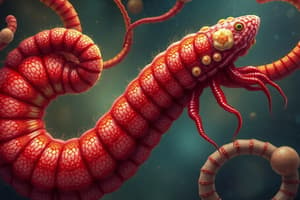Podcast
Questions and Answers
What is the primary characteristic of cestodes?
What is the primary characteristic of cestodes?
- They possess an oral and ventral sucker.
- They have a segmented body structure. (correct)
- They reproduce through direct life cycles.
- They have cylindrical body shapes.
Which helminth requires an intermediate host for its life cycle?
Which helminth requires an intermediate host for its life cycle?
- Toxocara canis
- Strongyloides spp.
- Taenia saginata (correct)
- Ascaris suum
Which of the following is NOT a common sign of helminth infection?
Which of the following is NOT a common sign of helminth infection?
- Diarrhea
- Weight gain (correct)
- Anemia
- Coughing
What is the main function of anthelmintics in the treatment of helminth infections?
What is the main function of anthelmintics in the treatment of helminth infections?
How do nematodes differ from cestodes in terms of their digestive system?
How do nematodes differ from cestodes in terms of their digestive system?
Which method is commonly used for diagnosing helminth infections?
Which method is commonly used for diagnosing helminth infections?
What preventive measure is effective against helminths?
What preventive measure is effective against helminths?
Which helminth has zoonotic potential and is a concern for public health?
Which helminth has zoonotic potential and is a concern for public health?
Flashcards are hidden until you start studying
Study Notes
Veterinary Parasitology: Helminthology
-
Definition: Helminthology is the study of helminths, which are parasitic worms affecting animals, including livestock and pets.
-
Types of Helminths:
-
Nematodes (roundworms):
- Cylindrical body shape
- Digestive system with both mouth and anus
- Common examples: Ascaris suum (pig roundworm), Toxocara canis (dog roundworm)
-
Cestodes (tapeworms):
- Flat, ribbon-like body structure
- Segmented body (proglottids)
- No digestive system; absorb nutrients through skin
- Common examples: Taenia saginata (beef tapeworm), Dipylidium caninum (flea tapeworm)
-
Trematodes (flukes):
- Flat, leaf-shaped body
- Have oral and ventral suckers
- Typically require an intermediate host (often a mollusk)
- Common examples: Fasciola hepatica (liver fluke), Dicrocoelium dendriticum (lancet liver fluke)
-
-
Life Cycles:
- Direct Life Cycle: Involves a single host where the parasite matures and reproduces (e.g., Toxocara canis).
- Indirect Life Cycle: Involves multiple hosts, including intermediate hosts necessary for development (e.g., Taenia saginata).
-
Transmission:
- Ingestion of eggs or larvae from contaminated food/water.
- Skin penetration by larvae (e.g., Strongyloides spp.).
- Vector transmission (e.g., fleas carrying tapeworm larvae).
-
Clinical Signs:
- Weight loss and poor condition.
- Diarrhea and gastrointestinal upset.
- Anemia (particularly with hookworms).
- Coughing (due to respiratory migration of larvae, in some cases).
-
Diagnosis:
- Fecal flotation and sedimentation tests for eggs/larvae.
- Serological tests for specific antibodies.
- Imaging techniques (e.g., ultrasound) for adult worms in some cases.
-
Treatment:
- Anthelmintics (dewormers) are the primary treatment.
- Common drugs: Fenbendazole, Pyrantel, Praziquantel, Ivermectin.
- Dosage and regimen depend on the type of helminth and host species.
- Anthelmintics (dewormers) are the primary treatment.
-
Prevention:
- Good hygiene practices, including regular cleaning of living areas.
- Regular deworming schedules for pets and livestock.
- Control of intermediate hosts (e.g., rodents, snails).
- Proper cooking of food to kill larvae and eggs.
-
Public Health Considerations:
- Zoonotic potential of certain helminths (e.g., Echinococcus granulosus).
- Importance of veterinary parasitology in food safety and animal health.
Helminthology Overview
- Study of helminths, parasitic worms that infect various animals, including pets and livestock.
Types of Helminths
-
Nematodes (Roundworms):
- Characterized by a cylindrical body shaped.
- Possess a complete digestive system with a mouth and anus.
- Notable examples include Ascaris suum (pig roundworm) and Toxocara canis (dog roundworm).
-
Cestodes (Tapeworms):
- Have a flat, ribbon-like body structure composed of segments called proglottids.
- Lack a digestive system; nutrients are absorbed through their skin.
- Common types include Taenia saginata (beef tapeworm) and Dipylidium caninum (flea tapeworm).
-
Trematodes (Flukes):
- Feature a flat, leaf-shaped body with oral and ventral suckers.
- Require an intermediate host, typically a mollusk, for lifecycle completion.
- Examples include Fasciola hepatica (liver fluke) and Dicrocoelium dendriticum (lancet liver fluke).
Life Cycles of Helminths
-
Direct Life Cycle:
- Involves a single host for maturation and reproduction.
- Example: Toxocara canis.
-
Indirect Life Cycle:
- Requires multiple hosts and includes an intermediate host.
- Example: Taenia saginata.
Transmission Routes
- Ingestion of contaminated food or water containing eggs or larvae.
- Skin penetration by larvae, as seen in Strongyloides spp.
- Vector-borne transmission, like fleas carrying tapeworm larvae.
Clinical Signs of Helminth Infection
- Weight loss and general poor condition in affected animals.
- Diarrhea and gastrointestinal disturbances.
- Anemia, especially associated with hookworm infections.
- Respiratory symptoms, such as coughing, due to larval migration.
Diagnosis Techniques
- Fecal flotation and sedimentation tests to detect eggs or larvae.
- Serological tests to identify specific antibodies against helminths.
- Imaging methods like ultrasound for observing adult worms.
Treatment Options
- Anthelmintics (dewormers) are the primary treatment for helminth infections.
- Commonly used drugs include Fenbendazole, Pyrantel, Praziquantel, and Ivermectin.
- Treatment regimens vary based on helminth type and host species.
Prevention Strategies
- Maintain good hygiene practices, including regular sanitation of living environments.
- Implement regular deworming protocols for pets and livestock.
- Manage populations of intermediate hosts such as rodents and snails.
- Ensure proper cooking of food to eliminate larvae and eggs.
Public Health Considerations
- Certain helminths, like Echinococcus granulosus, pose zoonotic risks.
- Veterinary parasitology plays a crucial role in influencing food safety and animal health.
Studying That Suits You
Use AI to generate personalized quizzes and flashcards to suit your learning preferences.





